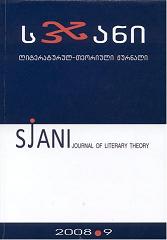სასწაულის კომპოზიცია
Composition of a Miracle
Author(s): Ivane AmirkhanashviliSubject(s): Literary Texts
Published by: ლიტერატურის ინსტიტუტის გამომცემლობა
Keywords: Hagiographic text; miracle; factologic and aesthetic functions
Summary/Abstract: What is a miracle and what is its role while constructing the Hagiographic text? From narrative viewpoint, a miracle represents a distinctive unit, possessing independent meaning and therefore, discussing its relation towards the text is not secured from self interpretations. To avoid misunderstanding, it is necessary to define what we mean in the concept of text in general– a sacred letter, a system of theological conjuncture or simply a fact of verbality. As an initial formula, text should be regard as a result of verbal creativity. At the same time, it should be noted that a miracle is not completely isolated from a text. In hagiographic texts miracle acquires definite function, which is characterized by distinguished signs. It is used as a proof for fixing Saint’s divine mission. In the general structure of narration it is included as an example or as a statement. Therefore, we should distinguish between factologic and aesthetic functions of a miracle. Source for hagiographic understanding of a miracle is biblical; the difference arises only when the author uses belletristic means, though the essence of biblical conception of miracle remains unchanged.
Journal: სჯანი
- Issue Year: 2008
- Issue No: 09
- Page Range: 11-18
- Page Count: 18
- Language: Georgian

